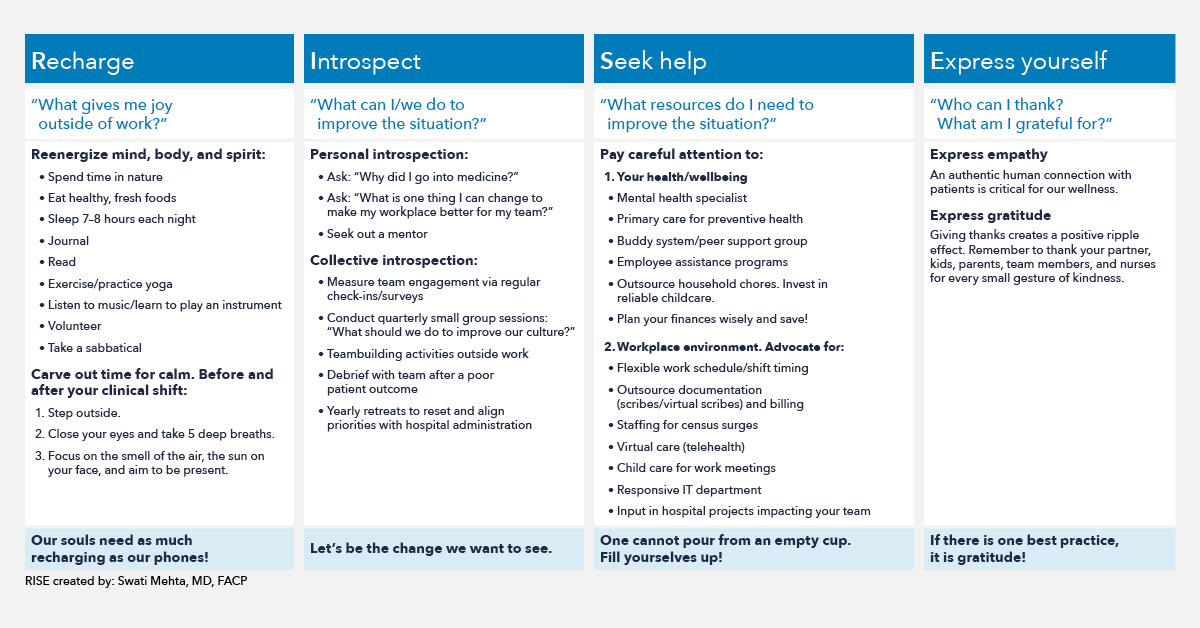In New York City, an emergency physician died by suicide after working tirelessly for weeks to save COVID-19 patients. In Indiana, a hospitalist ill with the virus manages a COVID unit via telehealth from his bedroom. Meanwhile, countless clinicians around the country grapple with financial insecurity and worry about spreading the virus to their loved ones.
For the millions of healthcare workers currently experiencing burnout, the pandemic has only exacerbated the pain. However, it’s important to hold on to hope. During these challenging times, there is still much we providers can do to preserve our wellness and career satisfaction.
What is burnout, and why does it matter?
The term burnout was originally coined in the 70s by psychologist Herbert Freudenberger:
“Burnout really is a response to stress, to frustration. It’s a response to a demand that an individual may make upon themself in terms of a requirement for perfectionism.”
Per ICD-11, burnout is:
“A syndrome resulting from chronic workplace stress that has not been successfully managed. It is characterized by feelings of energy depletion/exhaustion, increased mental distance from one’s job and reduced professional efficacy.”
In a 2020 survey of over 15,000 physicians in 29 specialties, 42% of respondents reported experiencing burnout symptoms. Existing studies of burnout in physician assistants suggest a burnout rate of 34–64%.[iv] A 2011 study found that 37% of hospital nurses engaged in direct patient care showed at least one symptom of burnout (emotional exhaustion). Results of a 2017 survey suggest that rates of nurse burnout may be rising.
For many overburdened caregivers, the COVID-19 pandemic feels like salt rubbed on a wound. Many providers are working at the brink of their limits to save lives while basic needs like personal protection equipment, childcare, and emotional support go unmet.
Burnout and its cascading effects cost the health care system approximately $4.6 billion a year. And the costs go far beyond finances. Burnout is toxic for patients as well as physicians because it’s associated with loss of empathy, impaired job performance, and increased incidence of medical errors.
How can we address burnout?
The good news is that hospitalists and other healthcare professionals are resilient by nature. Few others experience death, witness grief and deliver terrible news at the rate we do and keep coming back to work. However, it’s important to realize that we alone can’t fix the problem of burnout.
In my experience as a clinical leader, there are two important steps to addressing burnout. The first involves effecting systemic changes to lighten clinicians’ burdens. Examples include:
- Investing in user-friendly EHR technology
- Eliminating quality metrics that aren’t tied by evidence to patient outcomes
- Honoring diversity and creating opportunity for all
- Relieving administrative burden (for example, providing billing support)
- Adopting policies that improve patient access and experience
Of course, systemic change largely depends on our hospital administrators, regulators, and legislators. While providers can’t affect this type of change alone, we can influence it through our advocacy and engagement.
Step two, however, is squarely within our control as clinicians. Like the phoenix — a mythological creature that “burns out” only to rise from its own ashes —we all must rise and take control of our destiny for the sake of our colleagues, patients and communities.
We can combat burnout using the principles behind the RISE program, which I developed this year based on shared clinician experiences and the ways we have found ourselves to be most successful to thrive in challenging situations.
- Recharge
- Introspect
- Seek help
- Express yourself
Here’s how we can use R.I.S.E. to enhance our practice and well-being:

Research suggests that much burnout stems from a perceived lack of control over our work lives. As demands for standardization, productivity, quality, documentation, and risk management soar ever higher, it’s easy for us to feel like cogs in a machine. This is doubly true when layered over a pandemic that threatens our physical health and financial security.
However, while clinicians can’t change the system alone, there is much we can do to lift ourselves and rise like the phoenix. Currently, we plan to deploy this program as a pilot and encourage you to create a space in your department meeting to discuss RISE with your team as well!
We must always remember that we are members of the noblest of all professions. We are healers. This is our calling. We are not alone. We matter. We are at the heart of better care.



I think it’s a brilliant , encouraging article re-instilling confidence , guiding how to re- energise and enabling one to rise and be on the go once again! Organising , taking control of one’s life , techniques under R.I.S.E. strong willpower , having clear perspective and positive attitude surely facilitates us to The title ‘ The Phoenix Rises’ is absolutely apt – Congratulations ! And big gratitude for showing the way….
Excellent article Dr. Mehta
For me, preventing burnout is doing yoga
Thank you for this excellent piece on wellness and burnout. I really like the RISE concept. For me, the two most important components of that are to “recharge” and “seek help”. Why do Physicians inherently do a poor job of this? I‘ve been working to train myself to make sure I recharge without feeling guilty. And, asking for help comes in so many different ways. I want to continue to encourage the Physicians in my group to say to ourselves “it’s okay to not feel okay”.
Excellent article with practical tools to deal with burnout. First step in dealing with the problem is to acknowledge the problem and talk about it. I was told by a healthcare leader, “I don’t know what’s the whole buzz about burnout. Physicians are always burnout. It’s part of the job”. I felt sorry for him. He is more burnout than he realized. We talked and I shared this article and tools from Dr Swati Mehta. Hopefully we can use these simple and practical tools to help our peers, RISE up.
Wonderfully expressed especially the RISE concept . Physician – heal thyself . It’s ok not to be ok at times . It’s ok not to put a bold face always . It’s ok to be vulnerable at times . It’s ok to ask for help . It’s ok to accept imperfection at times . And have faith and trust in the Almighty.
I thought this a most insightful article. I’d add, however, we are missing a huge component of burnout in healthcare, care delivery systems that are a shambles throughout healthcare. We know approximately 94% of the outcomes we experience in healthcare, good and bad, are a function of the systems in which care providers work, not the efforts of those care providers. Care providers can do no better than the systems allow, within a range. In most cases, care providers are doing workarounds of systems that are in many cases bordering on dysfunctional. These systems are completely invisible to care providers and patients alike and so it looks like people are making mistakes or are uncaring or simply don’t know how to do the job right. But it gets worse for care providers.
The Nobel Prize winning Law of Dissipative Structures describes how systems that resist change in a changing environment become stressed and less efficient. Stressed systems in healthcare cause a number of things to happen, all of them bad. Quality of care, safety, patient experience and care provider morale go down and costs go up. That’s exactly what we’re seeing in healthcare. However, as applies to the burnout issue, there is one more critical component of stressed systems. The stress in systems, which is usually physical energy, is passed on to care providers and patients as emotional energy–Stress! Now we have chronic stress, accelerating over time, as the root or primary cause of care provider burnout. This stress also adversely affects patient experience and outcomes.
Most well intentioned efforts to reduce stress and combat burnout are addressing symptoms .I believe healthcare is heading to a dark place if we don’t begin to transform the systems where care is actually delivered. I’d push back a little on needing another top/down program/commitment to create this transformation. In fact, the transformation must occur bottom/up, led by front line champions of transformation with only minimal support and direction from the top. We know how to do this. Do we have the wisdom and the will?